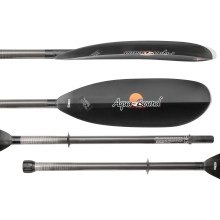A friend recently asked me for a recommendation on a paddle, as he had just bought a new (to him) boat. I’m not an expert on paddles, but I have tried a few and I have some definite opinions. You can spend both too much and too little money on a paddle. I have seen people spend good money on a boat and then get cheap with the paddle. This is a mistake. Your paddle is your engine. You often hold it up in front of you for hours. So weight, balance and blade shape can make a big difference in whether you enjoy your new boat or give up on it.
After renting kayaks for several years, Lisa surprised me one Christmas with my own boat (What a woman. I think I’ll keep her!). It was a big open double recreational kayak that I had been eyeing for some time. She had also purchased two paddles. They were light and looked sturdy, but I was appalled when she said she had paid $200.00 each for them. That was nearly a third of the cost of the boat! They were 230 cm Aquabound Stingray paddles that weighed under 30 ounces each. A little use proved the wisdom of not buying cheap paddles! I used them regularly with that boat and several others until this fall when I replaced them with 220 cm Aquabounds.
Sea kayak paddles are of two types: Greenland and Euro-blade. I have not used Greenland style paddles enough to have an opinion about them. They tend to be used by traditionalists who can be a bit fanatical in their enthusiasm for this design.
Euro-blades come in three styles. Each style has a different blade shape, with variations within each shape from manufacturer to manufacturer. These styles have blades to enhance high-angle paddling, low-angle paddling and a compromise or all-purpose blade with characteristics of both.
High-angle blades are designed for aggressive paddling, with the paddler placing the blade in the water near the side of the kayak and orienting the shaft almost vertically as he makes his stroke. These blades are shorter and broader than other blades and are used to go fast or give extra power inManta Ray - High Angle Blade
Low-angle blades are narrower and longer. Low-angle blades are designed for cruising, for covering long distances at a moderate speed. The low-angle paddler holds the paddle shaft lower in front of him, in a more nearly horizontal orientation, and places the blade in the water Eagle Ray - Low Angle Blade
The all-purpose paddle has a blade that is longer and narrower than the high-angle paddle, but shorter and wider than the low-angle paddle. It is intended to be an all around paddle, a good choice when you can only afford one good paddle.
When Lisa, was testing the boat we eventually bought for Stingray - An All-Purpose Blade
As for myself, I have tried several bent shaft paddles and I do not like them. I have some arthritis in my right hand and the bend in the shaft just seems to hit the affected joint badly. Also, the bent shaft forces my hands into fixed positions on the shaft. I like to place my hands at different spots on the paddle for relief from fatigue, for sweep strokes and to brace myself, all things I find more difficult or impossible to do with a bent shaft paddle.
The seemingly delicate nature of Lisa’s paddle puts me off too. I use my paddle to brace myself getting into and out of my boat. This puts a lot of strain on any paddle. I worry about that strain on an ultra-light paddle. Also, it is harder to enter and exit a boat with a bent shaft, or do a paddle float self-rescue. I use my paddle to push off of rocks, beaches, to pole through shallow water and even as protection under my kayak when I have to pull onto a rocky beach. I want a sturdy paddle at these times. I am willing to risk damaging a Lisa enjoying her Warner bent-shaft paddle on Lake Abanakee.
But there are other good, moderately priced paddles out there as well. You really need to try out a variety of blades. Most paddlers have definite opinions about paddles and usually favor the one they have chosen. They will often let you borrow their paddle for a limited time on day trips or longer so you can try out different manufacturers’ paddles and different styles.
I’d be interested in your opinions and experiences with paddles. Use the “Add a Comment” button below to share your opinion.











